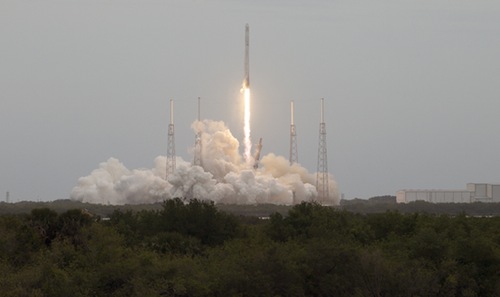
A SpaceX Falcon 9 v1.1 carrying a Dragon cargo spacecraft lifts off from Cape Canaveral, Florida, on Friday, April 18. It successfully placed a Dragon cargo spacecraft into orbit. (credit: NASA/KSC)
Despite a foreboding weather forecast, conditions were good enough at the right time Friday afternoon for SpaceX’s Falcon 9 v1.1 rocket to lift off successfully from Cape Canaveral, Florida. The rocket lifted off in its instantaneous launch window at 3:25:22 pm EDT (1925:22 GMT) and placed the Dragon spacecraft into orbit about ten minutes later. The Dragon separated, deployed its solar panels, and is on track to arrive at the International Space Station early on Easter Sunday, with grappling scheduled for 7:14 am EDT (1114 GMT).
“Everything looks great as far as the ascent phase of the mission,” SpaceX CEO Elon Musk said in a post-launch news conference late Friday afternoon. “The rocket flight was perfect, as far as we could tell.”
Musk did indicate there was a minor glitch with the Dragon itself noticed shortly after being released from the Falcon’s upper stage. “We had some slight initial challenges with Dragon, with respect to enabling some of the thruster quads, but those have been resolved, so it looks like everything’s good on the Dragon front,” he said. Later, he said the issue was with an isolation valve that feeds two of the spacecraft’s four thruster valves, but a backup valve resolved the problem. He said he wasn’t sure if this was related to the valve issues that caused problems for the previous Dragon mission, in March 2013.
Some people watching the launch noticed that, as soon as the Falcon 9’s nine first-stage engines ignited, there was a dark plume that rose up the sides of the vehicle, falling back down a few seconds later as the vehicle lifted off the pad. Musk said he believed that was linked to dousing the pad with water shortly before launch. “Essentially, what happened is we splashed dirty water on ourselves,” he said. “A little embarrassing, but no harm done.”
Besides launching the Dragon on the third of twelve contracted cargo missions to the ISS, many were interested in SpaceX’s effort to try and “land” the first stage in the ocean by performing engines burns that would be needed if the stage was going to land, as SpaceX eventually desires to do. As of the Friday afternoon press conference, there was only limited data available, Musk said, because the stage went over the horizon from the Cape; additional data collected by aircraft was expected back later this evening.
What data they did collect was promising. “We have good data down to a pretty low level, roughly around Mach 1.1. Everything looks fine, and we’re awaiting additional data to see how the potential landing burn went,” he said. One key aspect of the data they did have on hand, he said, was that they were able to stop the stage from rolling; it was that roll that caused the engines to shut down prematurely on the previous recovery effort last September when the spin pushed propellants to the sides of their tanks.
The weather conditions hampered efforts to support the recovery test: Musk said high seas kept recovery boats away from the landing zone, while NASA grounded a plane it planned to fly to observe the reentry because of icing conditions, NASA associate administrator Bill Gerstenmaier said at the post-launch press conference. Musk, participating in the press conference by phone, left early in order to get updates on data collected during recovery operations.
SpaceX vice president Hans Koenigsmann, also at the press conference, added that the data he saw from the recovery test looked “great” but that he hadn’t seen all of the data yet. He added that regardless of the outcome of this test, including any effort to try and recover the first stage after splashdown, they would likely do another, similar test on their next mission, carrying several ORBCOMM satellites, planned now for mid-May.
Update 8:30 pm: From a couple of updates from Elon Musk, it appears that the first stage of the Falcon 9 did successfully “land” in the ocean, although it has yet to be recovered:
Data upload from tracking plane shows landing in Atlantic was good! Several boats enroute through heavy seas.
— Elon Musk (@elonmusk) April 19, 2014
Flight computers continued transmitting for 8 seconds after reaching the water. Stopped when booster went horizontal.
— Elon Musk (@elonmusk) April 19, 2014

Leave a Reply